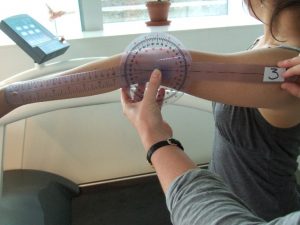Isobel Knight discusses new research, co-morbid conditions and management strategies for hypermobile Ehlers-Danlos Syndrome in this Q&A. Find Isobel Knight’s books on hypermobile Ehlers-Danlos Syndrome here.
For those who are unaware, could you briefly describe what hypermobility is?
A hypermobile joint is one that has a larger than normal range of movement. If you look at the figure of the elbow picture below, the joint looks ‘inside out’. Hypermobile people tend to be people we consider ‘flexible’ or ‘bendy’, and as such there is a high prevalence of hypermobility in the dance and performing arts sectors.
Hypermobility can be generalized at a range of joints – for example knees and elbows, or sometimes found in peripheral joints (e.g. hands and feet). It is perfectly possible to have joint hypermobility and be asymptomatic, but for some people their hypermobility can cause pain, dislocations, soft-tissue injuries and there can be other findings – such as extensible and stretchy skin which might be more suggestible of a form of heritable connective tissue disorder such as hypermobile Ehlers-Danlos Syndrome.
There are now new and strict diagnostic criteria in place to distinguish between those who have generalized or peripheral joint hypermobility through to those who have what is now called a Hypermobility Spectrum Disorder (HSD) or hypermobile Ehlers-Danlos Syndrome (hEDS). The diagnostic criteria that I discuss in my books refer to the old names of Hypermobility Syndrome or Ehlers-Danlos Syndrome Hypermobility-Type or Ehlers-Danlos Syndrome (Type III) – but although the name and diagnostic criteria have changed, the overall management strategies remain very much the same for these conditions.


hEDS is known to be a poorly understood condition. Have recent developments in research contributed to better understanding of it?
The overall reasons for changing the diagnostic criteria were for research purposes, and to ensure people get the correct diagnosis of hEDS or are given a diagnosis of HSD if they do not meet the criteria for hEDS. Another reason is that the criteria is based on exactly what we do know for certain. There are many other conditions (e.g. fatigue, gastrointestinal symptoms, anxiety, PoTS) that seem to co-exist alongside hEDS/HSD, but they are not included as part of the new diagnostic criteria because we cannot yet prove their association. The management of both conditions remains the same. One of the biggest problems is that there is not a genetic test yet for hEDS. We are hoping that it may be possible in the future.
What pain management strategies are available for those affected by hEDS?
There are a range of pain management strategies for those who experience pain with their hypermobility, or have some symptomatic form of Hypermobility Spectrum Disorder (HSD) or hEDS. It depends on what the pain is – whether it is an acute injury (perhaps a dislocation) – or a chronic, more persistent type of pain. Analgesia is an obvious one – and there many different types of medication that might be used. Things like heat and ice can help. The use of relaxation techniques is important in the management of the more long-term persistent pain that some people get as a result of their hypermobility. Exercise is also an important aspect of pain management, which is sometimes a difficult concept to contemplate when someone is in pain – but hypermobile joints need strengthening work.
How effective are complementary therapies in the treatment and management of HSD/hEDS? Which have you found to be particularly successful in managing HSD/hEDS?
Although physiotherapy is the evidence-based therapy for managing hypermobility and HSD/hEDS (because of the necessary strengthening work and exercises given), there are other treatments that patients may use to help with their symptoms. These might include Acupuncture, Osteopathy, Bowen Technique (a gentle-form of soft-tissue therapy founded in Australia, and massage. Anything that gives relief of symptoms, promotes sleep and relaxation and supports management of the condition – so long as it is beneficial for the sufferer.
You have written extensively on the comorbid conditions associated with HSD/hEDS, including fibromyalgia and IBS, which are also poorly understood conditions. How challenging is it to find an effective management strategy for these comorbid conditions alongside an effective management strategy for HSD/hEDS?
I like the new word ‘spectrum’ for HSD, because everyone is on a spectrum at any given time with their hypermobility (which we know declines with age) and they will be on a spectrum with absolutely no or minor musculoskeletal symptoms, through to having a range of other comorbid conditions in addition to their hypermobility, for example having fibromyalgia as well or IBS. Again, those with things like IBS might have minor symptoms from intermittent constipation through to severe constipation or possible evacuatory disorders because of experiencing pelvic organ prolapse.
Fatigue is a commonly associated problem and again can vary from mild to severely disruptive rendering some people occasionally bedbound – albeit briefly – until they recover. The management for fatigue is around pacing of activity, but it is not easy to avoid it completely – but again is on a spectrum. Sleep is a problem for many who experience symptomatic hypermobility.
Anxiety is another comorbid condition – but then again, is it any wonder people feel anxious who have unstable joints, and are feeling pain and frequently getting injured? It is often lonely and hard managing so many different symptoms on one’s own, leading to low mood. It is sometimes difficult for other people to understand all these different symptoms and feelings that can be going on for a person with HSD/hEDS.
There are many other conditions (e.g. fatigue, gastrotintestinal symptoms, anxiety, PoTS) that seem to co-exist alongside hEDS/HSD, but they are not included as part of the new diagnostic criteria because we cannot yet prove their association.
What improvements do you think could be made in the care of people affected by HSD/hEDS to help their recovery and management of their condition?
Early and more accurate diagnosis would help. The earlier the diagnosis, the faster management can begin.
Educating medical professionals is also essential – so we are hopeful that this can really happen with the updating of all the diagnostic criteria so that the medical professionals can be clear. I also hope it will stop some of the ongoing disbelief that some patients still experience – by the medical profession and also friends/family who do not understand the condition(s). A little understanding goes a long way. Sometimes the most powerful words a patient can hear are, “I believe you”.
Finally, much more research needs to go into hypermobility and related conditions so that we can find out for certain if, for example, gastrointestinal problems really are related to hypermobility, or not.
Despite the changes to names and amended diagnostic criterion, my books are still very relevant to readers in terms of both living with and managing hypermobility (spectrum disorders) and hEDS.
 Isobel Knight lives in North London and practices Bowen Technique in King’s Cross (www.bowenworks.org). She has published several books about Hypermobility and Ehlers-Danlos Syndrome and also co-authored a book about Bowen Technique. Read more about them here.
Isobel Knight lives in North London and practices Bowen Technique in King’s Cross (www.bowenworks.org). She has published several books about Hypermobility and Ehlers-Danlos Syndrome and also co-authored a book about Bowen Technique. Read more about them here.
If you would like to read more articles like this and hear the latest news and offers on our books, why not join our mailing list? We can send information by email or post as you prefer, and please also tell us about your areas of interest so we can send the most relevant information. You can unsubscribe at any time.
I am 61, diagnosed with Eds Hypermobil syndrom, but with
Some missing scores, 4 years ago.
I miss some information one the consequenses of having edsH in older age. I have worked hard since I was 14, having trouble with whit my joints sice childhood, have all the problems listed for my type of Eds, except the over mobility, of fingers and alboves.
Which was bending in childhood, but now they are stiffed of arthritis. My kneese and shoulders are still going out of place. I can still lay my hand one the floor with both hands, and straight legs. But skoliose, scheuermann, stenoses and damaged discos, kyfoses, has damaged my body. Now I can walk very much, crothes, rollator help my to walk but messes my shoulder and hands. I also have had problems with
My eyes, hearneyar, colon, giving birh etc.
I realy miss som rapports of analyses of long term effekt living with Eds Hypermobil. My son and grandchild show som aspects of edsH also.